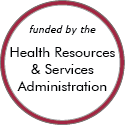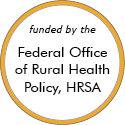Rural Project Examples: Medical homes
Effective Examples
NC-REACH: NC-Rurally Engaging and Assisting Clients who are HIV positive and Homeless

Updated/reviewed November 2020
- Need: Provision of medical care access and follow-up for rural North Carolina HIV patients with mental health, substance abuse, and unstable housing/homelessness challenges.
- Intervention: Medical home staff model expanded to a care coordination program with a core Network Navigator and Continuum of Care Coordinator assisting with medical, behavioral health, and basic life needs.
- Results: To date, the program has advanced three aspects of medical home patient care for this target population: provided further understanding of the spectrum of homelessness, including "hidden" homelessness; implemented outreach with creation of new community partnerships and a community housing coalition; and integrated medical care and behavioral health care for HIV.
Promising Examples
Atlantic General Hospital Patient Centered Medical Home
Updated/reviewed August 2022
- Need: Ways to reduce hospital admission rates, emergency department visits, and total cost of care while better accommodating patients of the Atlantic General Hospital Corporation.
- Intervention: The hospital system applied a patient centered medical home care model to their 7 rural outpatient clinics located throughout the Eastern Shore of Maryland and southern Delaware.
- Results: From the program's care coordination, care transitions, and intervention efforts, AGH saw improvements in quality-of-care processes, service use, and spending.
Other Project Examples
Clinic for Special Children
Updated/reviewed July 2023
- Need: To provide healthcare for the genetically vulnerable children and adults of the rural, uninsured Amish and Mennonite communities in southern Pennsylvania.
- Intervention: A clinic that serves as a comprehensive medical practice for children and adults (primarily from the Amish and Mennonite communities) with rare, inherited, or complex disorders.
- Results: In 2022, about 1,400 active patients with more than 400 unique genetic mutations were treated at the Clinic for Special Children.
Medical Home Plus

Updated/reviewed February 2020
- Need: To help reduce diabetes, depression, and stroke risk in rural residents.
- Intervention: A collaborative care model was implemented in the Idaho counties of Clearwater, Idaho, and Lewis.
- Results: Increased number of patients with controlled blood sugar, controlled blood pressure, and higher depression screening rates.
Optimal Health Behavioral Health Home Models
Updated/reviewed December 2019
- Need: A healthcare delivery model to improve health and well-being of Pennsylvania patients with serious mental illness in Pennsylvania, especially those in rural settings.
- Intervention: County human service administrators, patients, families, a behavioral health provider network, and a nonprofit behavioral health managed care organization implemented 2 versions of a behavioral home health model focusing on a complete culture of wellness.
- Results: These unique models significantly increased patient activation, engagement in both primary and specialty care, and improved client perception of their mental health status.
SAMA HealthCare Services's Patient-Centered Medical Home
Updated/reviewed February 2018
- Need: The traditional model where providers work independently from one another in treating patients proved to lack care continuity at SAMA Healthcare Services in rural Arkansas.
- Intervention: The family practice clinic shifted to a team-based model of care where the medical staff works together in pods in order to create a patient-centered medical home.
- Results: SAMA doubled the amount of patients seen in 1 day and at least 90% of patients receive medical treatment from a provider within their pod.
For examples from other sources, see:
